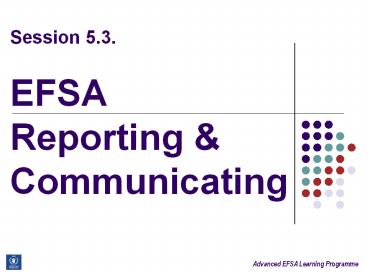Session 5.3. EFSA Reporting - PowerPoint PPT Presentation
1 / 9
Title:
Session 5.3. EFSA Reporting
Description:
Session 5.3. EFSA Reporting & Communicating Learning Objectives After this session, participants should be able to: Identify the end-users of EFSA reports List the ... – PowerPoint PPT presentation
Number of Views:91
Avg rating:3.0/5.0
Title: Session 5.3. EFSA Reporting
1
Session 5.3. EFSA Reporting Communicating
2
Learning Objectives
- After this session, participants should be able
to - Identify the end-users of EFSA reports
- List the components of the EFSA report
3
Where are we?
EFSA Process
Adapt conceptual framework objectives
Prepare analysis plan indicators, data, sources
Collect, review secondary data
Collect primary data
Conduct situation analysis
Conduct forecast analysis
Analyse response options
Make response recommendations
Prepare report
4
Reporting EFSA results
- Need for effective communication to support
decision-making - Adapted to Senior Managers Government, UN
country team, donors, humanitarian partners - Must be timely!
5
Who is the audience?
- Important to understand who the users are, and
which information they need or expect - Various needs, priorities and levels of
understanding - Food security is an inter-sectoral topic users
will belong to different agencies and backgrounds
6
Who is the audience of the WFP EFSA report?
Country Director Senior managers Programme
Officers Fund-raisers Logisticians
Government UN, NGOs Donors Media
7
Communication channels
- Report
- Executive Briefs
- Meetings with stakeholders
- Web page
- Press, media
8
Structure of an EFSA report (example 1)
- Executive summary
- 1. Background and type of EFSA
- Objectives and methodology
3. Food and nutrition security situation a) Food
availability and markets b) Households food
consumption, access and livelihoods c) Mortality
rates Malnutrition and its causes 4. Food and
non-food assistance being provided
5. Forecast and scenarios 6. Response options
and targeting 7. Recommendations
Annexes
9
Structure of EFSA report (example 2)
- Executive summary
- 1. Background and type of EFSA
- 2. Objectives and Methodology
3. Number and localisation of food insecure
households 4. Factors associated with food
insecurity a) Food availability and markets b)
Household food access and livelihoods c) Food
utilization (consumption, nutritional status,
health, mortality) 5. Food and non-food
assistance being provided
6. Forecasts and scenarios 7. Response options
and targeting 8. Recommendations
Annexes































